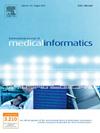Explainable prediction self-assessment model for potentially inappropriate prescribing risk in older adults
IF 4.1
2区 医学
Q2 COMPUTER SCIENCE, INFORMATION SYSTEMS
International Journal of Medical Informatics
Pub Date : 2025-10-09
DOI:10.1016/j.ijmedinf.2025.106137
引用次数: 0
Abstract
Background
Older adults with multiple chronic conditions often face challenges of potentially inappropriate prescribing (PIP). This study aimed to develop and validate an explainable machine learning (ML) model to predict PIP risk, aiding clinicians and patients in improving medication safety and self-management.
Methods
Data from geriatric outpatient prescriptions in six Chinese cities were analyzed using Chinese criteria. LASSO regression identified risk variables. Three machine learning (ML) models—logistic regression (LR), random forest (RF), and neural network (NN)—were training and internal validation (7: 3) and external validation cohort. Model performance was assessed via area under the ROC curve (AUC). SHapley Additive exPlanation (SHAP) values explained variable importance, and risk cutoff points were determined using the Youden index and prevalence data.
Results
Among 131,894 prescriptions, 29.00% (38,245) were PIP. The NN model with nonsampling performed best, with internal validation AUC of 0.759 (95%CI: 0.753 –0.764) and external validation AUC of 0.842 (95%CI: 0.816 –0.867). SHAP summary plots showed that the number of medications and sleep disorders were the most influential variables in basic prescription information and diagnoses, respectively. A predicted probability cutoff point of 29% was determined to classify low- and high-risk PIP categories. The optimal model was deployed as a web application (https://stoppip.online/pipview) for clinical use, and a WeChat mini-program was developed to facilitate self-assessment of PIP risk during outpatient follow-ups or home medication use.
Conclusion
The model was not only developed to predict PIP but can also be used by medical staff and older patients for self-assessment.
老年人潜在不当处方风险的可解释预测自我评估模型
背景患有多种慢性疾病的老年人经常面临潜在不适当处方(PIP)的挑战。本研究旨在开发和验证一个可解释的机器学习(ML)模型来预测PIP风险,帮助临床医生和患者提高药物安全性和自我管理。方法采用中国标准对全国6个城市老年门诊处方数据进行分析。LASSO回归识别风险变量。三个机器学习(ML)模型-逻辑回归(LR),随机森林(RF)和神经网络(NN) -进行训练和内部验证(7:3)和外部验证队列。通过ROC曲线下面积(AUC)评估模型性能。SHapley加性解释(SHAP)值解释了变量的重要性,并使用约登指数和患病率数据确定了风险截断点。结果131894张处方中,使用PIP的处方占29.00%(38245张)。非采样NN模型表现最好,内部验证AUC为0.759 (95%CI: 0.753 ~ 0.764),外部验证AUC为0.842 (95%CI: 0.816 ~ 0.867)。SHAP总结图显示,药物数量和睡眠障碍分别是影响基本处方信息和诊断的最大变量。确定了29%的预测概率截断点来划分低和高风险PIP类别。将最佳模型作为web应用程序(https://stoppip.online/pipview)部署用于临床使用,并开发微信小程序,以便在门诊随访或家庭用药期间对PIP风险进行自我评估。结论该模型不仅可用于PIP的预测,而且可用于医务人员和老年患者的自我评估。
本文章由计算机程序翻译,如有差异,请以英文原文为准。
求助全文
约1分钟内获得全文
求助全文
来源期刊

International Journal of Medical Informatics
医学-计算机:信息系统
CiteScore
8.90
自引率
4.10%
发文量
217
审稿时长
42 days
期刊介绍:
International Journal of Medical Informatics provides an international medium for dissemination of original results and interpretative reviews concerning the field of medical informatics. The Journal emphasizes the evaluation of systems in healthcare settings.
The scope of journal covers:
Information systems, including national or international registration systems, hospital information systems, departmental and/or physician''s office systems, document handling systems, electronic medical record systems, standardization, systems integration etc.;
Computer-aided medical decision support systems using heuristic, algorithmic and/or statistical methods as exemplified in decision theory, protocol development, artificial intelligence, etc.
Educational computer based programs pertaining to medical informatics or medicine in general;
Organizational, economic, social, clinical impact, ethical and cost-benefit aspects of IT applications in health care.
 求助内容:
求助内容: 应助结果提醒方式:
应助结果提醒方式:


